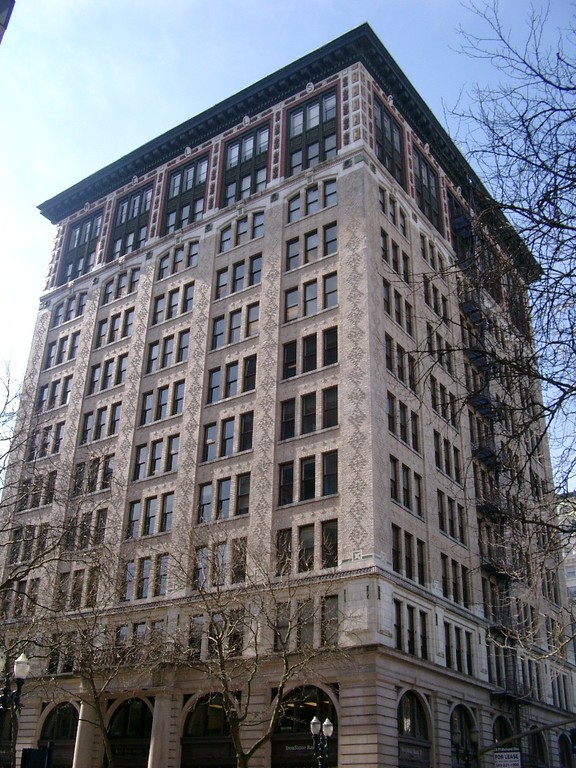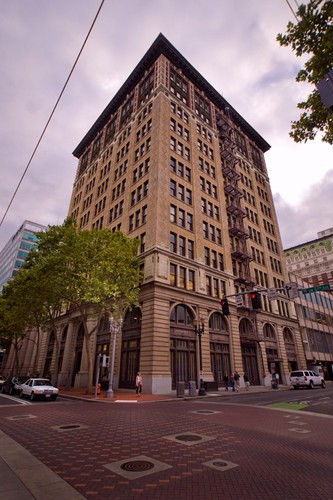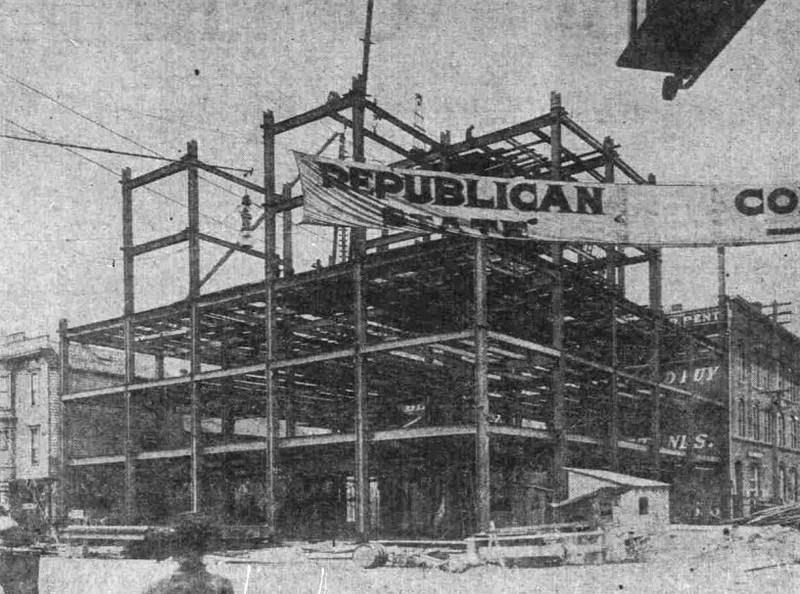Wells Fargo Building
Introduction
Text-to-speech Audio
Built in 1907, the twelve-story Wells Fargo Building remains today as one of Portland's best-preserved skyscrapers. At the time, the Wells Fargo building demonstrated Portland's growth, as well as the power of banks coming out of the Gilded Age, especially due to the success of the Lewis and Clark Exposition of 1905, which spurred tremendous economic growth, increased population, and a construction boom.
Images
By Ajbenj at English Wikipedia, CC BY 2.5, https://commons.wikimedia.org/w/index.php?curid=3536322

Bradley Maule via http://chatterbox.typepad.com/portlandarchitecture/2011/09/knowing-your-skyline-1907s-wells-fargo-building.html

1906 Construction (Source: By Unknown - The Sunday Oregonian, Public Domain, https://commons.wikimedia.org/w/index.php?curid=59429245)

Backstory and Context
Text-to-speech Audio
Built in 1907, the twelve-story Wells Fargo Building consists of steel-framed masonry construction, showing the direct influence of Chicago School architecture. It remains today as one of Portland's best-preserved skyscrapers. At the time, the Wells Fargo building demonstrated Portland's growth, as well as the power of banks coming out of the Gilded Age, especially due to the success of the Lews and Clark Exposition of 1905, which spurred tremendous economic growth, increased population, and a construction boom.
Not only did Wells Fargo do business in the building, but other notable, successful business of that time also called the building home, too, such as the Southern Pacific Railroad, and the Oregon Railway and Navigation Company.
Following the Lewis and Clark Exposition of 1905, the city's growth coincided with a shift in its economic center from the riverfront to the location where the Wells Fargo stands. The transformation of the area west of the river resulted in the replacement of Victorian-style mansions with warehouses and skyscrapers.
The history of Wells Fargo & Company in Portland and the state of Oregon speaks to the broader historical narrative of the era. Numerous private express companies grew eager to serve miners in Oregon during the gold-mining boom of the 1850s. Given that the principal goal of express companies involved receiving and forwarding gold dust and other valuables, many of them sought agencies for purposes safely storing its deposits. Hence, when the San Fransisco based Wells Fargo opened a branch in Portland, it quickly grew to become a dominant financial force that contributed heavily to railroad development and industrial growth.
As the Wells Fargo continued to expand during the late 19th century, it bought smaller companies and other competitors until it owned or controlled all of the stage lines from the Missouri River to California. Later, Wells Fargo adapted to changing trends and began investing in the railroad industry, which also allowed it to extend its influence eastward in the U.S., thus thrive financially. During Wells Fargo's peak, the company controlled more than 80,000 miles of railroad in addition to its local staging and water transport.
At the turn of the 20th century, Wells Fargo & Company didn't just find immense success locally and nationally, the company had bank branches in Asia, Europe and South America. By the time the building opened in 1907, Wells Fargo could boast of operating more than 100 branches in Oregon, aided substantially by the successful Lewis & Clark Exposition However, like many businesses during the turn of the 20th century, when Gilded Age laissez faire philosophies gave way to more progressive ideologies, Wells Fargo was split into two companies, the Wells Fargo Bank and the Wells Fargo Express. In 1905, as part of the reorganization of the company, the Portland Branch of the Wells Fargo Bank was sold to the U.S. National Bank. In that same year, the company purchased the land to build the Wells Fargo Building for its Express Department, which was disclosed in court when the sale was being reviewed.
At the turn of the 20th century, Wells Fargo & Company didn't just find immense success locally and nationally, the company had bank branches in Asia, Europe and South America. By the time the building opened in 1907, Wells Fargo could boast of operating more than 100 branches in Oregon, aided substantially by the successful Lewis & Clark Exposition However, like many businesses during the turn of the 20th century, when Gilded Age laissez faire philosophies gave way to more progressive ideologies, Wells Fargo was split into two companies, the Wells Fargo Bank and the Wells Fargo Express. In 1905, as part of the reorganization of the company, the Portland Branch of the Wells Fargo Bank was sold to the U.S. National Bank. In that same year, the company purchased the land to build the Wells Fargo Building for its Express Department, which was disclosed in court when the sale was being reviewed.
Plans went ahead for the building of the Wells Fargo tower, which became Portland's first skyscraper. In many ways, the building was both a blessing and a curse. The building marked Wells Fargo's long success, but the company's size and wealth also declined quickly after that. Shortly after the United States entered the First World War, the government took over control of the railroads and combined the nation's major express companies into one governmental agency with the name American Railway Express. Those government actions hurt Wells Fargo badly -- the company ceased to exist.
In 1922 the building was purchased by Andrew Porter, a prominent Portland investor, lumberman, and director of the U.S. National Bank. The building has seen numerous ownership changes since then.
Everything from westward migration, hopes of striking gold, Gilded Age and Progressive Era politics, the importance of banks and the railroad, the success of the Lewis and Clark Exposition, and World War -- to name a few -- are attached to the history of the Wells Fargo Building. It's as much a monument as it is a historical building.
Sources
Culverwell, Wendy. "Portland's first skyscraper passes the century mark." Portland Business Journal (Portland, Oregon), November 08, 2007. http://www.bizjournals.com/portland/stories/2007/11/19/focus2.html?b=1195448400^1552062
Maule, Bradley. Knowing your skyline: 1907's Wells Fargo Building. Portland Architecture. September 13, 2011. http://chatterbox.typepad.com/portlandarchitecture/2011/09/knowing-your-skyline-1907s-wells-fargo-bu....
Tess, John M. "Nomination Form." National Register for Historic Places. Published 09/12/1996. National Parks Department.
Maule, Bradley. Knowing your skyline: 1907's Wells Fargo Building. Portland Architecture. September 13, 2011. http://chatterbox.typepad.com/portlandarchitecture/2011/09/knowing-your-skyline-1907s-wells-fargo-bu....
Tess, John M. "Nomination Form." National Register for Historic Places. Published 09/12/1996. National Parks Department.
